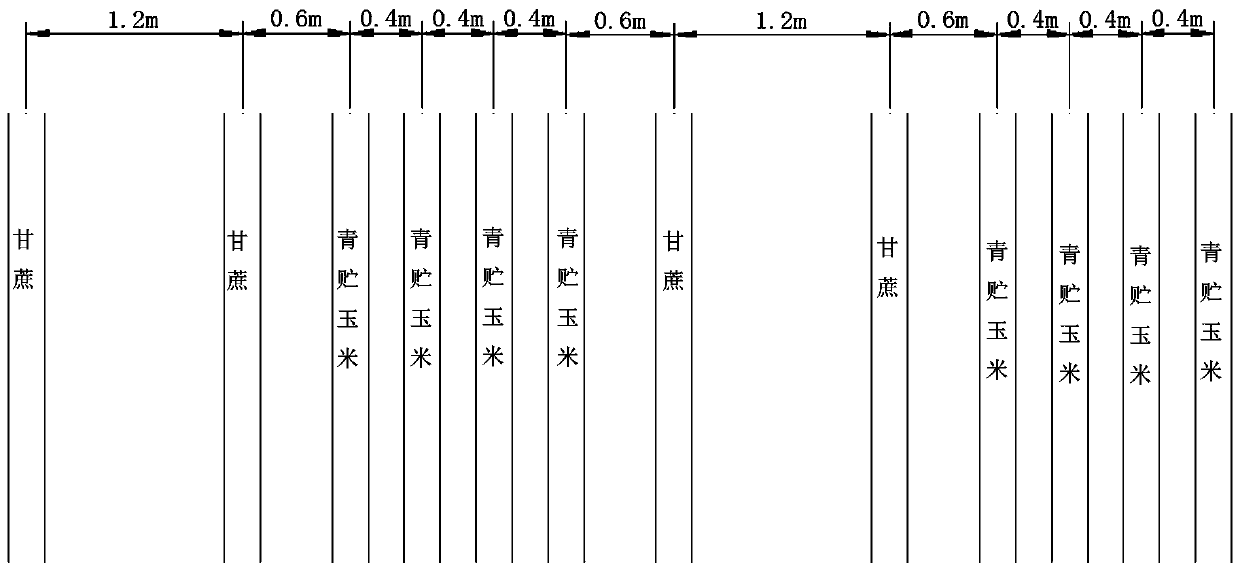Crop rotation and intercropping method for three crops including sugarcane, silage corn and millet
A technology for silage corn and sugarcane, which is applied in the field of crop rotation and intercropping of sugarcane, silage corn, and millet. It can solve the problems of sugarcane growth and development, high cost of sugar production, and changes in land physical and chemical properties. The effect of germ breeding, enhancing plant resistance, and strong tillering ability
- Summary
- Abstract
- Description
- Claims
- Application Information
AI Technical Summary
Problems solved by technology
Method used
Image
Examples
Embodiment 1
[0037] A method of crop rotation and intercropping of sugarcane, silage corn and millet is to intercrop sugarcane and millet or silage corn on a piece of land, and renovate the ratoon sugarcane field every 3 years, and plant sugarcane in the original Rotate millet or silage corn in the area where millet or silage corn was originally planted, and rotate sugarcane in the area where millet or silage corn was originally planted; the area where millet or silage corn is planted is a crop of millet and then a crop of silage corn, which is planted before sugarcane is closed, and sugarcane is closed. Later, only sugarcane will be planted. After the sugarcane is harvested, the stems will stay and the roots will be intercropped with millet or silage corn to achieve the harvest of one-stage sugarcane, one-stage millet and one-stage silage corn every year.
[0038] The specific rotation and intercropping methods of the method include the following steps:
[0039] (1) Before mid-January, use a h...
Embodiment 2
[0050] A method of crop rotation and intercropping of sugarcane, silage corn, and millet is to intercrop sugarcane and millet or silage corn on a piece of land, and renovate the ratoon sugarcane field every 4 years. Rotate millet or silage corn in the area where millet or silage corn was originally planted, and rotate sugarcane in the area where millet or silage corn was originally planted; the area where millet or silage corn is planted is a crop of millet and then a crop of silage corn, which is planted before sugarcane is closed, and sugarcane is closed. Later, only sugarcane will be planted. After the sugarcane is harvested, the stems will stay and the roots will be intercropped with millet or silage corn to achieve the harvest of one-stage sugarcane, one-stage millet and one-stage silage corn every year.
[0051] The specific rotation and intercropping methods of the method include the following steps:
[0052] (1) Before mid-January, use a high-horsepower tractor to plow the ...
Embodiment 3
[0063] A method of crop rotation and intercropping of sugarcane, silage corn and millet is to intercrop sugarcane and millet or silage corn on a piece of land, and renovate the ratoon sugarcane field every 5 years, and plant sugarcane in the original Rotate millet or silage corn in the area where millet or silage corn was originally planted, and rotate sugarcane in the area where millet or silage corn was originally planted; the area where millet or silage corn is planted is a crop of millet and then a crop of silage corn, which is planted before sugarcane is closed, and sugarcane is closed. Later, only sugarcane will be planted. After the sugarcane is harvested, the stems will stay and the roots will be intercropped with millet or silage corn to achieve the harvest of one-stage sugarcane, one-stage millet and one-stage silage corn every year.
[0064] The specific rotation and intercropping methods of the method include the following steps:
[0065] (1) Before mid-January, use a h...
PUM
 Login to View More
Login to View More Abstract
Description
Claims
Application Information
 Login to View More
Login to View More - R&D
- Intellectual Property
- Life Sciences
- Materials
- Tech Scout
- Unparalleled Data Quality
- Higher Quality Content
- 60% Fewer Hallucinations
Browse by: Latest US Patents, China's latest patents, Technical Efficacy Thesaurus, Application Domain, Technology Topic, Popular Technical Reports.
© 2025 PatSnap. All rights reserved.Legal|Privacy policy|Modern Slavery Act Transparency Statement|Sitemap|About US| Contact US: help@patsnap.com



